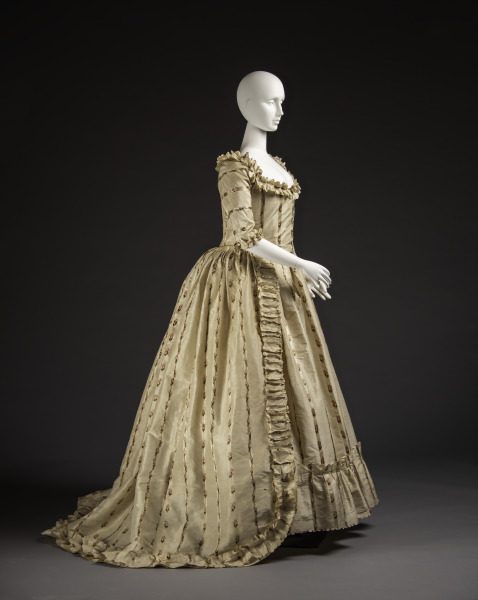The Mint Museum has pieces of its collection spread across two buildings; Mint Museum Uptown and Mint Museum Randolph. These collections can be seen on view alongside our special exhibitions.
The Mint Museum is working diligently to ensure that all objects from our collection are represented on our website, at this time only a portion are available for view.
silk silk satin
Not currently on view
Museum Purchase: Auxiliary Costume Fund
A robe à la Anglaise displayed a fitted bodice, a décolleté (low cut) neckline, and an attached overskirt. The skirt, then called a petticoat, may or may not have matched the fabric of the dress. Wide skirts were supported by panniers (side hoops) to create the silhouette of this fashionable style. In the 18th century, Chiné silk was a highly prized commodity imported from China. For centuries, the Chinese guarded their secret of making silk from the fibrous cocoons of tiny silk worms. When a silk cocoon is placed in boiling water, the filament releases and can be wound upon a spool. Each filament can measure between 1,900 and 2,800 feet. One silk thread is made by twisting five to eight filaments together. The thread may then be woven into a fine, soft fabric or used for embroidery work.
Accession Number: 2003.104a-b
Measurements:
Copyright Information:
Public Domain
In order to access a high-resolution image, please submit a request via the Mint’s Reproduction Request Form. Fees may apply.

silk silk satin
Not currently on view
Museum Purchase: Auxiliary Costume Fund
A robe à la Anglaise displayed a fitted bodice, a décolleté (low cut) neckline, and an attached overskirt. The skirt, then called a petticoat, may or may not have matched the fabric of the dress. Wide skirts were supported by panniers (side hoops) to create the silhouette of this fashionable style. In the 18th century, Chiné silk was a highly prized commodity imported from China. For centuries, the Chinese guarded their secret of making silk from the fibrous cocoons of tiny silk worms. When a silk cocoon is placed in boiling water, the filament releases and can be wound upon a spool. Each filament can measure between 1,900 and 2,800 feet. One silk thread is made by twisting five to eight filaments together. The thread may then be woven into a fine, soft fabric or used for embroidery work.
Accession Number: 2003.104a-b
Measurements:
Copyright Information:
Public Domain
In order to access a high-resolution image, please submit a request via the Mint’s Reproduction Request Form. Fees may apply.

All records for works of art published on mintmuseum.org have been reviewed by curatorial staff but may be incomplete. Our collections database comprises information gathered over the museum’s history; consequently, some records may be missing information, include offensive or discriminatory language, or reflect outdated ideas and analyses. The Mint is committed to addressing these issues and revising our records so as to maintain the highest possible degree of accuracy in accordance with scholarly standards.
If you would like to suggest improvements to a record, please submit your feedback here.
The Museum assumes no responsibility for infraction of copyright laws, invasion of privacy or improper and /or illegal use that may arise from reproduction of this image. The user assumes full responsibility for the use of images obtained from the Museum, to obtain permission from copyright holders where applicable and to hold harmless the Museum and its agents against any and all damages and claims arising or resulting from the use of the images.